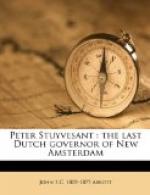Soon several canoes approached the vessel, and the natives came on board, bringing with them green tobacco and corn, which they wished to exchange for knives and beads. Many vessels, engaged in fishing, had touched at several points on the Atlantic coast, and trafficked with the Indians. The inhabitants of this unexplored bay had heard of these adventurers, of the wonders which they brought from distant lands, and they were in a state of great excitement, in being visited in their turn.
The bay was fringed with the almost impenetrable forest. Here and there were picturesque openings, where Indian villages, in peaceful beauty, were clustered in the midst of the surrounding foliage. The natives were dressed in garments of deer skin, very softly tanned, hanging gracefully about their persons, and often beautifully ornamented. Many of them wore mantles of gorgeously-colored feathers, quite artistically woven together; and they had also garments of rich furs.
The following morning a party from the vessel landed, in a boat, on the Jersey shore. They were received with great hospitality by the natives, who led them into their wigwams, and regaled them with dried currants, which were quite palatable. As they had no interpreters, they could only communicate with each other by signs. They found the land generally covered with forest trees, with occasional meadows of green grass, profusely interspersed with flowers, which filled the air with fragrance.
Another party of five men, was sent to examine the northern shore of the bay. They probably inflicted some gross outrage upon the natives, as the crew of the Half Moon had conducted infamously, at other points of the coast, where they had landed, robbing and shooting the Indians. The sun had gone down, and a rainy evening had set in, when two canoes impelled rapidly by paddles, overtook the returning boat. One contained fourteen Indians; the other twelve. Approaching within arrow shot, they discharged a volley into the boat. One of these keen-pointed weapons, struck John Coleman in the throat, and instantly killed him. Two other Englishmen were wounded.
The Indians seemed satisfied with their revenge. Though they numbered twenty-six warriors, and there were but two white men left unwounded, the savages permitted them to continue their passage to the vessel, without further molestation. The journalist, who records this assault, is silent respecting the provocation which led to it.
Hudson was alarmed by this hostility, and expected an immediate attack upon the ship. He promptly erected bulwarks along the sides of his vessel as a protection from the arrows of the fleet of war canoes, with which, he supposed, he would be surrounded the next morning.
But the night passed quietly away; the morning dawned, and a few canoes approached from another part of the bay, with no signs of hostility. These peaceful Indians had manifestly heard nothing of the disturbance of the night before. They came unarmed, with all friendly attestations, unsuspicious of danger, and brought corn and tobacco, which they offered in exchange for such trinkets as they could obtain. The next morning, two large canoes approached from the shores of the bay which was many leagues in extent, one of which canoes seemed to be filled with warriors, thoroughly armed. The other was a trading boat.




